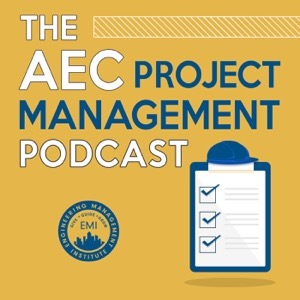How Combining Engineering and Architecture Skills Can Create Better Projects – Ep 059
The AEC Project Management Podcast - Un pódcast de Anthony Fasano, P.E., AEC PM, F. ASCE - Lunes

Categorías:
In this episode, I talk with Jamison Morse, P.E., R.A., principal and director of buildings + structures at PVE-LLC at PVE, LLC, about how the dual expertise of engineering and architecture shapes dynamic project management and drives the core elements of successful AEC projects. ***The video version of this episode can be viewed here.*** Engineering Quotes: Here Are Some of the Questions I Asked Jamison: How has your experience as both an engineer and architect influenced how you manage AEC projects? How do you ensure BIM and other technologies align with your team’s project management goals? What strategies do you use to handle regulatory compliance challenges like New York City’s local laws 11 and 37? How do you balance innovative architectural design with structural integrity when working with engineering and architecture teams? How do you manage inspections, repairs, and restorations of aging infrastructure while addressing time, cost, and safety concerns? Will the software you’re developing stay in-house, or do you plan to license it to other firms? What lessons from managing diverse teams can help AEC project managers improve communication and coordination? What final piece of advice would you give AEC project managers for leading successful projects and building strong client relationships? What is the biggest challenge you’ve faced as a project manager, and how would you recommend solving it? Here Are Some Key Points Discussed in This Episode About How Combining Engineering and Architecture Skills Can Create Better Projects: Leveraging dual expertise enables professionals to understand diverse roles within a project and align them for cohesive teamwork. By committing to long-term growth, leaders build comprehensive knowledge that enhances team performance and positions them to guide projects effectively. Equipping team members with tools aligned to their strengths and providing targeted training ensures the effective use of BIM and other technologies. Clear systems and consistent teamwork drive innovation and align efforts with project goals. Offering free educational seminars and utilizing automated systems like checklists and reporting tools ensures compliance processes remain straightforward and organized. These methods minimize errors, promote consistency, and elevate team efficiency in regulatory work. Aligning team strengths and encouraging collaboration ensures designs achieve both creativity and structural soundness. Providing resources for innovation and enabling open communication helps professionals deliver practical and visionary solutions. Creating innovative tools streamlines inspections and decision-making, reducing time and costs while maintaining safety and quality. Refining these tools over time improves efficiency and supports industry-wide progress by addressing evolving challenges. Sharing internally developed tools with other firms strengthens collaboration and elevates industry standards. By focusing on continuous improvement and accessibility, these innovations tackle shared challenges in infrastructure and project management. Bringing teams together in person builds trust, connection, and open communication. Face-to-face interaction is crucial for aligning perspectives, resolving challenges, and building a unified and effective team. Establishing trust through accountability and prioritizing humanity over shortcuts is essential for long-term success. Strong relationships grow when professionals emphasize consistent improvement, transparent communication, and meaningful collaboration. A significant challenge is avoiding burnout while addressing numerous issues simultaneously. The solution lies in prioritizing tasks,
